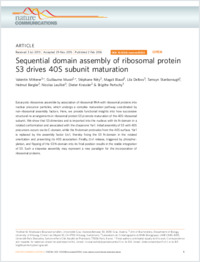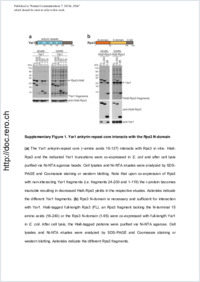Sequential domain assembly of ribosomal protein S3 drives 40S subunit maturation
- Mitterer, Valentin Institut fu¨r Molekulare Biowissenschaften, Universität Graz, Austria
- Murat, Guillaume Unit of Biochemistry, Department of Biology, University of Fribourg, Switzerland
- Réty, Stéphane Laboratoire de Cristallographie et RMN Biologiques, UMR CNRS 8015, Université Paris Descartes, France
- Blaud, Magali Laboratoire de Cristallographie et RMN Biologiques, UMR CNRS 8015, Université Paris Descartes, France
- Delbos, Lila Laboratoire de Cristallographie et RMN Biologiques, UMR CNRS 8015, Université Paris Descartes, France
- Stanborough, Tamsyn Institut fu¨r Molekulare Biowissenschaften, Universität Graz, Austria
- Bergler, Helmut Institut fu¨r Molekulare Biowissenschaften, Universität Graz, Austria
- Leulliot, Nicolas Laboratoire de Cristallographie et RMN Biologiques, UMR CNRS 8015, Université Paris Descartes, France
- Kressler, Dieter Unit of Biochemistry, Department of Biology, University of Fribourg, Switzerland
- Pertschy, Brigitte Institut fu¨r Molekulare Biowissenschaften, Universität Graz, Austria
-
02.02.2016
Published in:
- Nature Communications. - 2016, vol. 7, p. 10336
English
Eukaryotic ribosomes assemble by association of ribosomal RNA with ribosomal proteins into nuclear precursor particles, which undergo a complex maturation pathway coordinated by non-ribosomal assembly factors. Here, we provide functional insights into how successive structural re-arrangements in ribosomal protein S3 promote maturation of the 40S ribosomal subunit. We show that S3 dimerizes and is imported into the nucleus with its N-domain in a rotated conformation and associated with the chaperone Yar1. Initial assembly of S3 with 40S precursors occurs via its C- domain, while the N-domain protrudes from the 40S surface. Yar1 is replaced by the assembly factor Ltv1, thereby fixing the S3 N-domain in the rotated orientation and preventing its 40S association. Finally, Ltv1 release, triggered by phosphorylation, and flipping of the S3 N-domain into its final position results in the stable integration of S3. Such a stepwise assembly may represent a new paradigm for the incorporation of ribosomal proteins.
- Faculty
- Faculté des sciences et de médecine
- Department
- Département de Biologie
- Language
-
- English
- Classification
- Biological sciences
- License
- License undefined
- Identifiers
-
- RERO DOC 260630
- DOI 10.1038/ncomms10336
- Persistent URL
- https://folia.unifr.ch/unifr/documents/304783
Other files
Statistics
Document views: 75
File downloads:
- kre_sda.pdf: 185
- kre_sda_sm.pdf: 80

